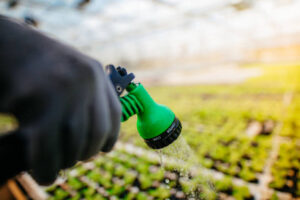Grekkon Limited’s delivery pipe price in Kenya is for 2″ and 3″ diameter layflat pipes for irrigation, which are available as 30M and 50M in length with a thickness of PN4 and PN8. Our delivery layflat pipes are 2 types based on constituent material;
- Poly vinyl chloride (PVC) delivery pipes. In easy to store as it lays flat; it is common in sprinkler irrigation
2. Canvas delivery layflat pipes

A 30M roll of PN4 3″ canvas delivery pipe
The cotton canvas pipe has a PVC lining on the inside that makes it water proof
- Material:PVC is a solid plastic material, while canvas is a woven fabric.
- Flexibility:PVC pipes are generally rigid, while canvas pipes are more flexible and can be easily bent.
- Waterproofing:Pure canvas is not fully waterproof, so most canvas pipes have a PVC coating to make them water resistant.
- Applications:PVC pipes are commonly used for drainage systems, while canvas pipes are often used for temporary water delivery in construction, irrigation, or firefighting due to their flexibility and ability to be easily transported.














































